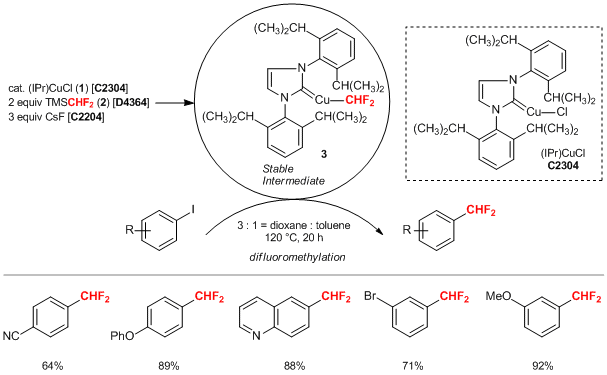Maintenance Notice (3:15 - 7:30 AM February 22, 2025 UTC): This website is scheduled to be unavailable due to maintenance. We appreciate your patience and understanding.
Notice of Discontinuing the Use of Password-Protected Compressed Files | Product Document Searching Made Easy by 2D Code! | TCI Life Science News February 2025 | [Product Highlights] Chemiluminescent Reagents for... | Various analytical charts can be searched on each product detail page and Product Document Search (The kinds of analytical charts differ by product)
Maximum quantity allowed is 999
Please select the quantity
Difluoromethylation of Aryl Iodides using a (NHC)Cu(CHF2) Complex
Sanford et al. have reported that difluoromethylations using a (NHC)Cu(CHF2) complex (3) can be prepared/isolated from a copper(I) / N-heterocyclic carbene (NHC) complex of chloro[1,3-bis(2,6-diisopropylphenyl)imidazol-2-ylidene]copper(I) (1) and (difluoromethyl)trimethylsilane (2). According to their report, previously isolated Cu(I) complex 3 stoichiometrically reacts with various functional group’s substituted aryl iodides and affords the corresponding difluoromethylated compounds in good yield. While, in the presence of cesium fluoride, this reaction can be applied to the catalytic difluoromethylation by the use of catalytic amounts of Cu(I) complex 1 and 2 equivalents of 2 as a difluoromethane source. In general, difluoromethylated copper(I) complex species (“Cu(I)-CHF2”) are considered to be unstable and difficult to isolate. However, this report shows isolation of that Cu(I) species by complexation as a (NHC)Cu(CHF2) complex using a NHC ligand.

References
- Synthesis, Reactivity, and Catalytic Applications of Isolable (NHC)Cu(CHF2) Complexes